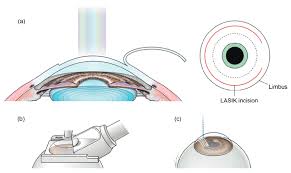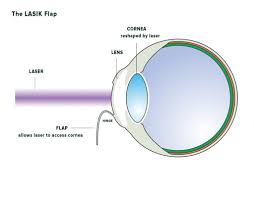Table of Contents
ToggleAre you frustrated with the hassle of glasses or contact lenses due to your nearsightedness?
If you have a prescription of -5.25 or similar, you might be wondering whether LASIK surgery could provide a lasting solution for your vision correction needs.
LASIK (Laser-Assisted In Situ Keratomileusis) has emerged as a popular and effective option for correcting refractive errors like myopia (nearsightedness), but its suitability can vary based on individual prescriptions and eye health factors.
Let’s explore in detail whether LASIK is a viable choice for you.
Understanding Your Prescription
To begin, let’s decode what a -5.25 prescription signifies.
In eyeglass prescriptions, the numbers denote the degree of refractive error measured in diopters.
A prescription of -5.25 indicates moderate to high myopia.
With this level of nearsightedness, distant objects appear blurry without corrective lenses.
Criteria for LASIK Eligibility
LASIK can be transformative for those who qualify. The ideal candidates generally possess the following characteristics:
– Age: LASIK is generally recommended for individuals aged 18 and older, ensuring that their prescription has stabilised and their corneal thickness is less likely to change significantly.
– Stable Vision: Your vision prescription should have remained relatively unchanged for at least a year before considering LASIK. This indicates that your vision has stabilised, reducing the likelihood of regression after surgery.
– Good Eye Health: Candidates should be free of eye diseases, infections, or conditions that could impair healing post-surgery.
– Adequate Corneal Thickness: LASIK involves reshaping the cornea, so it’s essential that your cornea has sufficient thickness to safely accommodate this procedure.
-Realistic Expectations: While LASIK can significantly reduce your dependence on corrective eyewear, it’s important to understand that perfect vision cannot always be guaranteed.
Can You Get LASIK with a -5.25 Prescription?
Having a -5.25 prescription generally falls within the range that LASIK can effectively correct.
However, it’s just one piece of the puzzle. Several other factors, such as corneal thickness, pupil size, and overall eye health, determine your candidacy for LASIK surgery.
It’s crucial to undergo a thorough evaluation by a qualified ophthalmologist or LASIK surgeon to determine your candidacy.
Evaluating Corneal Thickness
Corneal thickness is a critical factor in LASIK candidacy.
The laser used in LASIK surgery reshapes the cornea by removing a precise amount of tissue.
Adequate corneal thickness is crucial to ensure sufficient tissue remains after the procedure. If your cornea is too thin, LASIK may not be advisable.
Your eye doctor will measure your corneal thickness using a technique called pachymetry to ensure it meets the requirements for LASIK.
Assessing Other Eye Health Factors
In addition to corneal thickness, your eye doctor will evaluate the overall health of your eyes.
Conditions such as dry eye syndrome, keratitis, glaucoma, or cataracts could impact your suitability for LASIK.
Any existing eye diseases or infections need to be addressed and stabilised before considering surgery.
Risks and Complications
Like any surgical procedure, LASIK carries potential risks and complications, albeit rare. These may include dry eyes, halos or glare, overcorrection or undercorrection, and in rare cases, vision loss.
Understanding these risks and discussing them with your eye care provider is crucial in making an informed decision about LASIK.
The Importance of a Comprehensive Eye Exam
To accurately assess your suitability for LASIK, a thorough consultation with an experienced ophthalmologist is essential. This examination will include:
– A detailed review of your medical history and vision-related issues.
– A comprehensive eye examination, encompassing visual acuity tests, refraction testing, and corneal topography. Corneal topography provides detailed mapping of your cornea to assess its shape and thickness.
– Exploration of alternative vision correction options in case LASIK is not appropriate for you.
Benefits of LASIK for -5.25 Prescription
If you are deemed a suitable candidate for LASIK with a -5.25 prescription, the benefits can be life-changing:
– Reduced Dependence on Corrective Lenses: Many patients achieve 20/20 vision or better after LASIK, eliminating or significantly reducing the need for glasses or contacts.
– Improved Quality of Life: Freedom from glasses or contacts can enhance daily activities, sports, and overall lifestyle.
– Quick Recovery: Most patients experience rapid recovery and improved vision within days after LASIK.
Alternatives to LASIK
If LASIK is not recommended based on your eye health or other factors, several alternative procedures may be suitable.
Photorefractive Keratectomy (PRK), for instance, is a similar laser eye surgery that can be considered for individuals with thinner corneas or specific eye health issues.
Another option could be the Implantable Collamer Lens (ICL), also known as Visian ICL. This involves implanting a small lens behind the iris to correct vision without altering corneal tissue. This option is suitable for individuals with high prescriptions or thin corneas.
Choosing the Right Vision Correction Option
Choosing the right vision correction method depends on your specific needs and eye health. During your consultation, your ophthalmologist will discuss the pros and cons of each option based on factors like your prescription, corneal thickness, lifestyle, and budget. Here are some key questions to ask your doctor:
– Which vision correction method offers the best results for my specific prescription and eye health?
– What are the potential risks and side effects associated with each option?
– What is the recovery time for each procedure?
– What are the long-term considerations for each vision correction method?
By openly discussing these questions with your ophthalmologist, you can make an informed decision about the vision correction solution that best aligns with your goals and expectations.
Looking Ahead
In conclusion, having a -5.25 prescription does not automatically disqualify you from undergoing LASIK surgery.
The key is to consult with a qualified eye care professional who can assess your individual eye health and determine the most appropriate treatment for your needs.
LASIK has provided life-changing results for many individuals with myopia, but it’s essential to approach this decision with realistic expectations and a thorough understanding of the procedure and potential outcomes.
Take the first step by scheduling a comprehensive eye exam to explore your options for achieving clearer vision without glasses or contacts.
LASIK has transformed the lives of countless individuals with myopia, offering newfound freedom from glasses and contacts. However, each person’s eyes are unique, and it’s essential to undergo a thorough evaluation with a qualified eye care professional to determine if LASIK is the right choice for your specific needs and vision goals.













